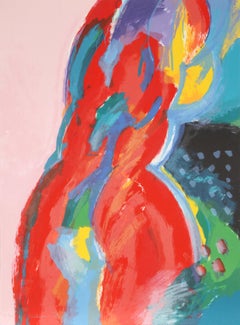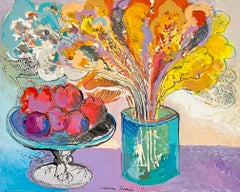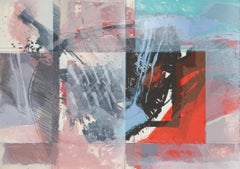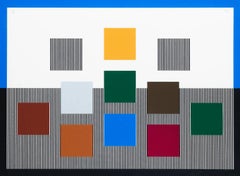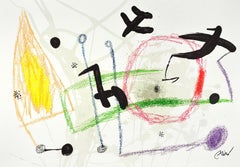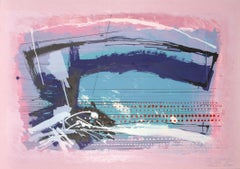Calman Shemi Prints and Multiples
Argentinian, b. 1939
Calman Shemi was born in Argentina in 1939. He studied sculpture and ceramics at the School of Mendoza in Argentina. In 1961, Shemi emigrated to Israel, and in 1963 he began studying sculpture with Rudi Lehman. He created his first "soft" paintings in 1977. Since 1978, he has worked primarily in serigraphy and acrylic paintings. In 1999, Shemi developed the "windows" and the "lacquer" painting techniques. The "window" or "shadow box" painting is a unique form of artistic expression. First Shemi creates a painting in a wooden box. After completion of the painting, he affixes a customized wooden frame to the box. This unusual technique results in the illusion of looking through a window to the landscape or into a room. The frame is then covered with silver or gold leaf and finally lacquered. The final result is a piece of art that emphasizes the contrast between the outside level and the painting within a deeper level.
Lacquer paintings are also one of Shemi's original creations. These works usually begin as an exciting abstract design or still-life painted on wood or on a metal panel that has been covered in layers of gold and/or silver leaf. After the paint has dried, the painting is gilded with many layers of lacquer. Between each layer of lacquer the surface is hand polished to give it a metallic finish, resulting in a luminous effect.
Remarkably, artist Shemi has had 71 one-man shows all around the world, including Israel, France, Singapore, Nigeria, Australia, Japan, Canada, Spain Germany, the United States and elsewhere. His works are displayed in the Spertus Museum of Judaica, the Fashion Institute of Chicago, Citibank in New York, the Hebrew University in Jerusalem, just to name a few.to
1
1
2
Overall Width
to
Overall Height
to
3
10
1,171
919
894
818
3
2
1
2
1
3
Artist: Calman Shemi
Through the Window, Colorful Abstract Lithograph by Calman Shemi
By Calman Shemi
Located in Long Island City, NY
Artist: Calman Shemi, Argentine (1939 - )
Title: Untitled I
Medium: Lithograph, signed and numbered in pencil
Edition: HC 60/450
Size: 34.5 in. x 26 in. (87.63 cm x 66.04 cm)
Category
Late 20th Century Abstract Calman Shemi Prints and Multiples
Materials
Lithograph
$720 Sale Price
20% Off
Unique Modernist Israeli Still Life Monoprint Painting Calman Shemi Vase Flowers
By Calman Shemi
Located in Surfside, FL
Fruit and Flowers monoprint by Calman Shemi
Calman Shemi, sculptor and painter, was born in Argentina in 1939. A graduate of the School of Sculpture and Ceramics in Mendoza, he studied under the Italian-Argentinean sculptor Libero Badii whom he credits with putting him on the right path. “He taught me principals, not only related to sculpture, but human and philosophic principals. Shemi also carefully studied the work of such masters as Pablo Picasso, Caravaggio, Frank Stella and Henri Matisse. “From each one of these great artists I learned something from observing them,” he says.
In 1961, at the age of 20, Shemi immigrated to Israel and joined Kibbutz Carmia of which he was a member for twenty years. There he worked in agriculture and also as a sculptor working with wood and clay. Several of his large-scale fiberglass and polyester sculpture projects are situated in public buildings. He was a student of German-Israeli sculptor Rudi Lehmann, a pioneer of the artistic movement known as “Canaanism.”
Canaanite art was an effort to create a direct relationship with the land, bypassing historic Jewish connotations—hence the land’s primordial name is used. Canaanite works, with an emphasis on the inter-action of simple shapes, bear a deliberate resemblance to the sculpture and ritual art of early civilizations of the Middle East prior to Judaism, always with an eye to the fusion of man and the land itself.
Though sculpture dominated his early years as an artist, in the mid ’70s Shemi developed the idea of the “soft painting” medium. Beginning with a color drawing done to scale, Shemi layers onto the drawing irregularly shaped pieces of variously textured and colored fabrics. Using a threadless 9,000-needle sewing machine, the fabrics are meshed to one another and to the background, resulting in vibrant wool tapestry carpet compositions infused with exuberant color and explosive movement.
Over the years, Shemi has continued to challenge himself with new artistic mediums, developing two more techniques of painting: “Lacquer paintings” and “window paintings.” He also works in monotype, lithograph and silkscreen techniques. He creates his Lacquer Painting by applying vibrant colors to wood or metal panel that has been gilded with gold or silver leaf, and sometimes both. After the oil paint has thoroughly dried, many layers of lacquer are applied to the surface giving it a glowing effect. Between each layer of lacquer the piece is hand-polished to give the surface its very shiny look.
Shemi’s “lacquer” and “window” paintings are reminiscent of ancient techniques used centuries ago in Japan and China.
Shemi concludes, “All of the art that I create is full of optimism and beauty. That’s all. Simple, very simple.”
During the past eighteen years Shemi has held more than seventy one-man shows in the U.S., Japan, Germany, Spain, Belgium and Israel. His works can be seen in many public and private collections around the world. He is of a generation of contemporary Israeli artists, somewhat influenced by pop art that include Alex Pauker...
Category
20th Century Abstract Expressionist Calman Shemi Prints and Multiples
Materials
Monoprint
Between Fog & Clarity, Colorful Abstract Lithograph by Calman Shemi
By Calman Shemi
Located in Long Island City, NY
Artist: Calman Shemi, Argentine (1939 - )
Title: Between Fog & Clarity
Medium: Lithograph, signed in pencil
Edition: 300, Dedicated to Michel
Size: 25 in. x 35.5 in. (63.5 cm x 90.17...
Category
Late 20th Century Abstract Calman Shemi Prints and Multiples
Materials
Lithograph
Related Items
Composition 1996
By Jesús Rafael Soto
Located in Miami, FL
Composition 1996
Silkscreen in colors on Arches paper
21.7 x 29.5 in (55 x 75 cm)
Editioned upper left and signed upper right
Edition of 99
Jesús Rafael Soto was born on June 5, 19...
Category
1960s Abstract Geometric Calman Shemi Prints and Multiples
Materials
Lithograph
Joan Miró - MARAVILLAS CON VARIACIONES... Lithograph Contemporary Art Abstract
By Joan Miró
Located in Madrid, Madrid
Joan Miró - Maravillas con variaciones acrósticas en el jardín de Miró V
Date of creation: 1975
Medium: Lithograph on Gvarro paper
Edition: 1500
Size: 49,5 x 71 cm
Observations: Lith...
Category
1970s Abstract Calman Shemi Prints and Multiples
Materials
Paper, Lithograph
$1,167
H 19.49 in W 27.96 in
"AD 177" Abstract Painting 79" x 79" inch by Ahmed Dafrawy
By Ahmed Dafrawy
Located in Culver City, CA
"AD 177" Abstract Painting 79" x 79" inch by Ahmed Dafrawy
Medium: Mixed Media on Canvas
Dafrawy’s fine arts academic background started in 2014 when he received the certificate of...
Category
21st Century and Contemporary Abstract Expressionist Calman Shemi Prints and Multiples
Materials
Canvas, Acrylic
$8,500
H 79 in W 79 in D 1 in
Joan Miró - MARAVILLAS CON VARIACIONES.. Lithograph Contemporary Art Abstraction
By Joan Miró
Located in Madrid, Madrid
Joan Miró - Maravillas con variaciones acrósticas en el jardín de Miró XIII
Date of creation: 1975
Medium: Lithograph on Gvarro paper
Edition: 1500
Size: 49,5 x 71 cm
Condition: In v...
Category
1970s Abstract Calman Shemi Prints and Multiples
Materials
Paper, Lithograph
$1,167
H 19.49 in W 27.96 in
Joan Miró - MARAVILLAS CON VARIACIONES... Lithograph Contemporary Art Abstract
By Joan Miró
Located in Madrid, Madrid
Joan Miró - Maravillas con variaciones acrósticas en el jardín de Miró XX
Date of creation: 1975
Medium: Lithograph on Gvarro paper
Edition: 1500
Size: 49,5 x 35,5 cm
Condition: In v...
Category
1970s Abstract Calman Shemi Prints and Multiples
Materials
Paper, Lithograph
$933
H 19.49 in W 13.98 in
"Song of Spring", Perfect for entryway, narrow wall, or gallery-style hanging!
By Michelle Thomas Artist
Located in Woodstock, GA
“Song of Spring” – Textured Vertical Abstract Painting with Natural Renewal by Michelle Thomas.
“Song of Spring” is a lively original abstract expressionist painting that captures t...
Category
21st Century and Contemporary Abstract Expressionist Calman Shemi Prints and Multiples
Materials
Canvas, Varnish, Acrylic
$821 Sale Price
20% Off
H 54 in W 8 in D 1.5 in
Joan Miró - MARAVILLAS CON VARIACIONES... Lithograph Contemporary Art Abstract
By Joan Miró
Located in Madrid, Madrid
Joan Miró - Maravillas con variaciones acrósticas en el jardín de Miró XVIII
Date of creation: 1975
Medium: Lithograph on Gvarro paper
Edition: 1500
Size: 49,5 x 35,5 cm
Observations...
Category
1970s Abstract Calman Shemi Prints and Multiples
Materials
Lithograph
$933
H 19.49 in W 13.98 in
Minuit
By Auguste Herbin
Located in Miami, FL
Minuit - From the 12 plate Portfolio, 1959
Published by Denise Rene, Paris
Lithograph in colors on heavy paper
20 x 26 inches
Signed, dated and numbered in ink, edition of 150 copies...
Category
1950s Abstract Geometric Calman Shemi Prints and Multiples
Materials
Lithograph
Vendredi
By Auguste Herbin
Located in Miami, FL
Vendredi - Plate 10 from the 12 plate Portfolio, 1959
Published by Denise Rene, Paris
Lithograph in colors on heavy paper
20 x 26 inches
Signed, dated and numbered in ink, edition 20...
Category
1950s Abstract Geometric Calman Shemi Prints and Multiples
Materials
Lithograph
untitled
By Richard Hunt
Located in New York, NY
untitled lithograph drawn in 2022 and published in an edition of 43. Measuring 36 by 25 inches, the work is designated number 9 of 43 lower left and signed in pencil "R Hunt...
Category
2010s Abstract Calman Shemi Prints and Multiples
Materials
Lithograph
"Margarita Time!"- Original Art, Textured, Rich Tones, Vibrant
By Michelle Thomas Artist
Located in Woodstock, GA
Sip on the Vibrant Vibes of 'Margarita Time!'
This fun, wild and crazy piece is a fiesta for the eyes. Transport yourself to a tropical paradise and feel the rhythm as you indulge ...
Category
21st Century and Contemporary Abstract Expressionist Calman Shemi Prints and Multiples
Materials
Canvas, Acrylic
$1,320 Sale Price
49% Off
H 18 in W 18 in D 1.5 in
Joan Miró - MARAVILLAS CON VARIACIONES... Lithograph Contemporary Art Abstract
By Joan Miró
Located in Madrid, Madrid
Joan Miró - Maravillas con variaciones acrósticas en el jardín de Miró XV
Date of creation: 1975
Medium: Lithograph on Gvarro paper
Edition: 1500
Size: 49,5 x 71 cm
Condition: In ver...
Category
1970s Abstract Calman Shemi Prints and Multiples
Materials
Lithograph
$1,167
H 19.49 in W 27.96 in
Previously Available Items
Manuscript, Colorful Abstract Lithograph by Calman Shemi
By Calman Shemi
Located in Long Island City, NY
Artist: Calman Shemi, Argentine (1939 - )
Title: Manuscript
Medium: Lithograph, signed in pencil
Edition: 300, Dedicated to Michel
Size: 25 in. x 35.5 in. (63.5 cm x 90.17 cm)
Category
Late 20th Century Abstract Calman Shemi Prints and Multiples
Materials
Lithograph
Calman Shemi prints and multiples for sale on 1stDibs.
Find a wide variety of authentic Calman Shemi prints and multiples available for sale on 1stDibs. If you’re browsing the collection of prints and multiples to introduce a pop of color in a neutral corner of your living room or bedroom, you can find work that includes elements of orange and other colors. You can also browse by medium to find art by Calman Shemi in lithograph and more. Much of the original work by this artist or collective was created during the 20th century and is mostly associated with the abstract style. Not every interior allows for large Calman Shemi prints and multiples, so small editions measuring 26 inches across are available. Customers who are interested in this artist might also find the work of Cristina Ghetti, Jay Rosenblum, and Antonio Peticov. Calman Shemi prints and multiples prices can differ depending upon medium, time period and other attributes. On 1stDibs, the price for these items starts at $750 and tops out at $900, while the average work can sell for $900.
